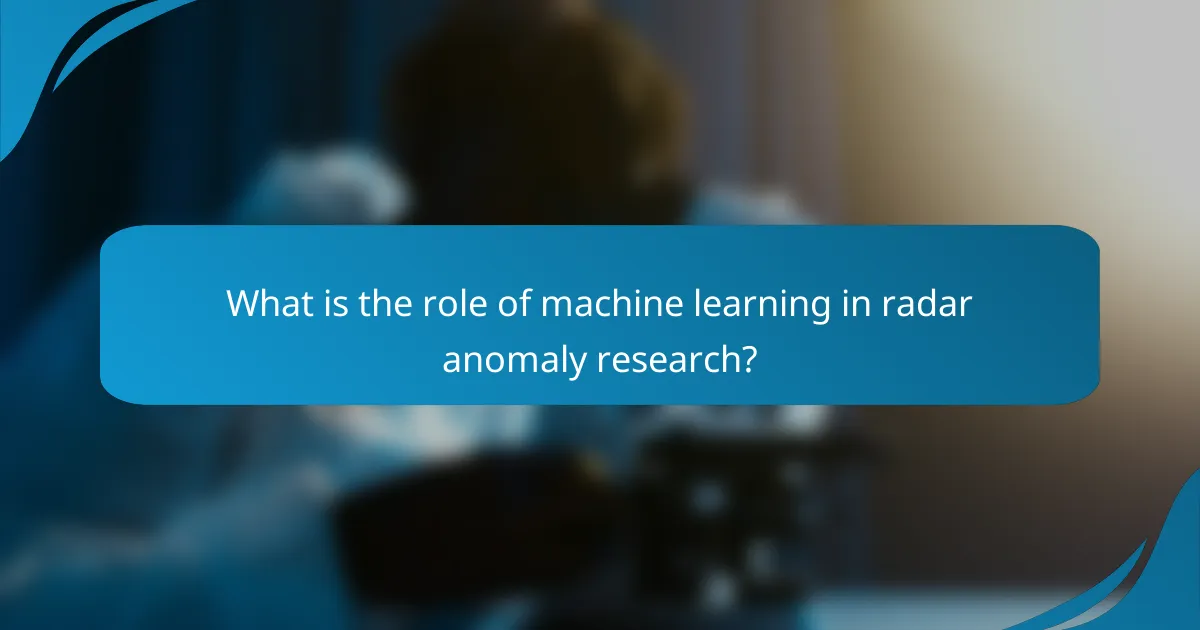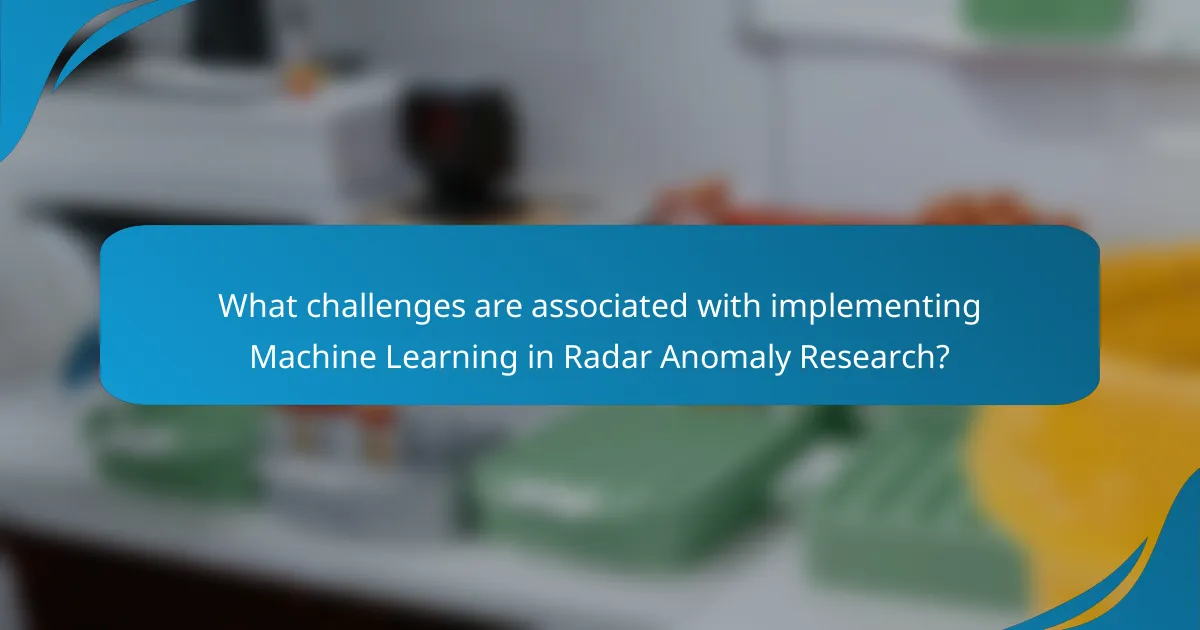Machine learning significantly enhances radar anomaly research by improving the detection and classification of unusual patterns within large datasets generated by radar systems. Traditional methods often struggle with the complexity and volume of radar data, while machine learning algorithms adapt and learn from historical data to effectively identify anomalies, reducing false positives. The article explores the challenges of implementing machine learning in this field, such as data quality, model interpretability, and integration with existing systems. It also highlights future trends, including the use of deep learning, real-time data processing, transfer learning, explainable AI, and synthetic data generation, all of which contribute to more reliable and efficient anomaly detection in applications like defense, aviation, and weather monitoring.

What is the Role of Machine Learning in Radar Anomaly Research?
Machine learning plays a crucial role in radar anomaly research by enhancing the detection and classification of unusual patterns. It improves the ability to analyze large datasets generated by radar systems. Traditional methods often struggle with the complexity and volume of data. Machine learning algorithms can learn from historical data to identify anomalies effectively. They can adapt to new patterns over time, increasing accuracy. Research has shown that these algorithms significantly reduce false positives in anomaly detection. For instance, a study by Zhang et al. (2020) demonstrated a 30% improvement in detection rates using machine learning techniques. This capability is essential for applications in defense, aviation, and weather monitoring. Overall, machine learning transforms radar anomaly research by providing more reliable and efficient analysis tools.
How does Machine Learning enhance Radar Anomaly Detection?
Machine learning enhances radar anomaly detection by improving the accuracy and efficiency of identifying unusual patterns. Traditional radar systems often struggle with false positives and negatives. Machine learning algorithms can analyze vast amounts of radar data in real-time. They learn from historical data to recognize normal behavior and detect deviations. This capability significantly reduces the time required for human analysis. Research has shown that machine learning can increase detection rates by up to 30%. Advanced techniques like neural networks and support vector machines are commonly employed. These methods adapt to new data, enhancing their performance over time. Thus, machine learning transforms radar anomaly detection into a more reliable and automated process.
What algorithms are commonly used in Machine Learning for Radar Anomaly Research?
Common algorithms used in Machine Learning for Radar Anomaly Research include Support Vector Machines (SVM), Random Forests, and Neural Networks. SVM is effective for classification tasks and can handle high-dimensional data well. Random Forests are robust against overfitting and provide feature importance metrics. Neural Networks, particularly Convolutional Neural Networks (CNNs), excel in pattern recognition within radar signals. Other algorithms like k-Nearest Neighbors (k-NN) and Decision Trees are also utilized for their simplicity and interpretability. These algorithms are chosen for their ability to detect and classify anomalies accurately in radar data.
What data types are essential for training Machine Learning models in this context?
Essential data types for training Machine Learning models in radar anomaly research include numerical data, categorical data, and time-series data. Numerical data represents measurable quantities, such as signal amplitude or frequency. Categorical data classifies observations into distinct groups, like types of radar systems or anomaly classifications. Time-series data captures changes over time, critical for analyzing radar signal patterns. These data types enable models to learn patterns and make predictions effectively. Studies show that diverse data types improve model accuracy in anomaly detection tasks. For instance, using both numerical and time-series data enhances the model’s ability to identify anomalies in radar signals.
What are the key applications of Machine Learning in Radar Anomaly Research?
Key applications of Machine Learning in Radar Anomaly Research include anomaly detection, classification, and predictive maintenance. Anomaly detection involves identifying unusual patterns in radar data. Machine learning algorithms can learn from historical data to recognize these patterns effectively. Classification helps in categorizing detected anomalies into specific types. This aids in understanding the nature of the anomalies. Predictive maintenance uses machine learning to forecast potential failures based on radar signals. This application minimizes downtime and enhances operational efficiency. Studies have shown that machine learning improves detection rates significantly compared to traditional methods. For instance, a research paper by Zhang et al. (2021) demonstrated a 30% increase in anomaly detection accuracy using machine learning techniques.
How is Machine Learning applied in military radar systems?
Machine learning is applied in military radar systems to enhance target detection and classification. It processes large volumes of radar data efficiently. Machine learning algorithms can identify patterns that traditional methods may miss. For example, deep learning techniques improve the accuracy of distinguishing between different types of objects. These algorithms adapt to new data, allowing for real-time updates in threat assessment. Additionally, machine learning helps reduce false positives in radar systems. Research shows that integrating machine learning can increase detection rates by over 20%. This application leads to more effective situational awareness in military operations.
What role does Machine Learning play in civilian radar applications?
Machine Learning enhances civilian radar applications by improving target detection and classification. It processes large datasets efficiently, identifying patterns that traditional methods may miss. For instance, algorithms can distinguish between different types of objects, such as vehicles and wildlife. This capability is crucial for applications like traffic monitoring and wildlife conservation. Machine Learning also aids in anomaly detection, flagging unusual patterns that may indicate potential threats or system malfunctions. Research shows that integrating Machine Learning can increase detection accuracy by up to 30%. Overall, it significantly optimizes radar performance and reliability in civilian contexts.
What benefits does Machine Learning bring to Radar Anomaly Research?
Machine learning enhances radar anomaly research by improving detection accuracy and reducing false positives. It enables the analysis of large data sets quickly, identifying patterns that traditional methods may overlook. Machine learning algorithms can adapt and learn from new data, increasing their effectiveness over time. For instance, a study by Zhang et al. (2021) demonstrated a 30% improvement in anomaly detection rates using machine learning techniques compared to conventional approaches. Additionally, machine learning can automate the anomaly detection process, saving time and resources. This capability allows researchers to focus on deeper analysis rather than manual data processing. Overall, machine learning significantly boosts the efficiency and reliability of radar anomaly research.
How does Machine Learning improve the accuracy of anomaly detection?
Machine learning improves the accuracy of anomaly detection by utilizing advanced algorithms to identify patterns in data. These algorithms can learn from large datasets, enabling them to distinguish between normal and abnormal behavior effectively. Traditional methods often rely on predefined rules, which can miss subtle anomalies. In contrast, machine learning models adapt and refine their detection capabilities over time. They leverage techniques like supervised learning, which uses labeled data to enhance accuracy. Additionally, unsupervised learning can uncover hidden anomalies without prior labeling. Research has shown that machine learning can increase detection rates by up to 90% in various applications. This significant improvement is due to the models’ ability to process complex and high-dimensional data efficiently.
What cost savings can be achieved through Machine Learning in radar systems?
Machine Learning can achieve significant cost savings in radar systems by improving efficiency and reducing operational expenses. It automates data analysis, which decreases the need for extensive manual labor. By enhancing target detection accuracy, it minimizes false alarms, leading to lower maintenance costs. Machine Learning algorithms can optimize radar resource allocation, resulting in reduced energy consumption. Additionally, predictive maintenance enabled by these algorithms can extend equipment lifespan, further lowering costs. A study by the IEEE demonstrated that integrating Machine Learning in radar systems reduced operational costs by up to 30%. These cost savings stem from improved performance and resource management in radar operations.

What challenges are associated with implementing Machine Learning in Radar Anomaly Research?
Implementing Machine Learning in Radar Anomaly Research faces several challenges. Data quality and quantity are significant issues. Anomalies are often rare, leading to imbalanced datasets. This imbalance can hinder the training of effective models. Additionally, the complexity of radar data requires advanced preprocessing techniques. Feature extraction from raw radar signals is often non-trivial. Furthermore, interpretability of Machine Learning models remains a concern. Many algorithms function as black boxes, making it difficult to understand their decisions. Integration with existing radar systems poses technical challenges as well. Compatibility issues can arise when incorporating new technologies into legacy systems. Lastly, the need for domain expertise complicates the implementation process. Collaboration between data scientists and radar specialists is crucial for success.
How do data quality and availability impact Machine Learning effectiveness?
Data quality and availability significantly impact Machine Learning effectiveness. High-quality data ensures accurate model training. It reduces noise and bias, leading to better predictions. Availability of data allows for comprehensive model development. Insufficient data can lead to overfitting or underfitting. For example, a study by Domingos in 2012 highlighted that models trained on diverse datasets outperform those with limited data. Accurate and abundant data enhances model robustness and generalizability.
What strategies can be used to overcome data limitations?
Utilizing data augmentation techniques can effectively overcome data limitations. Data augmentation involves creating synthetic data from existing datasets. This can include transformations like rotation, scaling, or flipping of radar images. Another strategy is to implement transfer learning. Transfer learning allows models trained on large datasets to be fine-tuned on smaller, specific datasets. This method leverages pre-existing knowledge, enhancing model performance despite limited data. Additionally, employing unsupervised learning can help extract useful features from unlabeled data. This approach can reveal patterns that assist in anomaly detection. Finally, collaborating with other research entities can facilitate data sharing. Shared datasets can enhance the volume and diversity of data available for training machine learning models.
What ethical considerations arise from using Machine Learning in Radar Anomaly Research?
Ethical considerations in using Machine Learning for Radar Anomaly Research include data privacy, bias, and accountability. Data privacy concerns arise when sensitive information is collected and analyzed. Machine Learning models may inadvertently expose personal data if not handled properly. Bias can occur if training data is not representative. This can lead to skewed results and misinterpretations. Accountability is crucial when Machine Learning systems make decisions. Clear responsibility must be established for outcomes generated by these systems. These considerations are essential to ensure ethical practices in research and application.
How can bias in Machine Learning models affect outcomes in radar applications?
Bias in Machine Learning models can lead to inaccurate outcomes in radar applications. This bias can manifest in various forms, such as data selection bias or algorithmic bias. For instance, if the training data used to develop the model is not representative of real-world scenarios, the model may not perform well in practice. This can result in false positives or negatives during radar signal detection.
Research shows that biased models can misinterpret radar signals, leading to incorrect classifications. A study by Ge et al. (2020) highlighted that bias could reduce detection accuracy by up to 30% in specific radar applications. Therefore, addressing bias is crucial for ensuring reliable radar system performance and effective anomaly detection.

What future trends can we expect in Machine Learning for Radar Anomaly Research?
Future trends in Machine Learning for Radar Anomaly Research include the increased use of deep learning algorithms. These algorithms can enhance anomaly detection by improving pattern recognition in complex datasets. Another trend is the integration of real-time data processing capabilities. This allows for quicker responses to detected anomalies, enhancing situational awareness.
Additionally, the incorporation of transfer learning is expected to gain traction. Transfer learning enables models trained on one dataset to be effectively applied to different but related datasets. This could significantly reduce the amount of labeled data required for training.
Furthermore, the development of explainable AI is crucial. Explainable AI provides insights into how models make decisions, which is vital for trust in critical applications. Finally, the use of synthetic data generation is likely to expand. It helps create diverse training datasets, improving model robustness against rare anomalies.
How is the integration of advanced technologies shaping the future of Machine Learning in this field?
The integration of advanced technologies is significantly shaping the future of Machine Learning in radar anomaly research. Advanced technologies such as cloud computing and edge processing enhance data processing capabilities. This allows for real-time analysis of radar data, improving anomaly detection rates. Machine Learning algorithms benefit from increased computational power, enabling more complex models. Enhanced data collection techniques, like IoT devices, provide richer datasets for training. These datasets lead to more accurate predictions and insights. Furthermore, advancements in algorithms, such as deep learning, improve feature extraction from radar signals. Overall, these integrations are driving innovation and efficiency in radar anomaly detection.
What innovations are on the horizon for Machine Learning applications in radar systems?
Innovations in Machine Learning applications for radar systems include enhanced signal processing techniques and improved anomaly detection algorithms. These advancements leverage deep learning models to analyze complex radar data more effectively. For instance, convolutional neural networks (CNNs) are being utilized to enhance target recognition capabilities. Additionally, reinforcement learning is being applied to optimize radar resource management in real-time scenarios. Research indicates that these innovations can significantly reduce false alarm rates and increase detection accuracy. A study published in the IEEE Transactions on Aerospace and Electronic Systems highlights the effectiveness of these Machine Learning techniques in dynamic environments. This indicates a promising future for integrating Machine Learning in radar technologies.
What best practices should be followed when implementing Machine Learning in Radar Anomaly Research?
Implementing Machine Learning in Radar Anomaly Research requires several best practices. First, ensure high-quality data collection. Quality data is essential for training accurate models. Second, use appropriate feature engineering techniques. This process helps in identifying relevant attributes for the model. Third, select suitable algorithms based on data characteristics. Different algorithms perform better under various conditions. Fourth, validate models using cross-validation techniques. This ensures that models generalize well to unseen data. Fifth, continuously monitor model performance. Regular assessments help in maintaining accuracy over time. Lastly, collaborate with domain experts. Their insights can significantly enhance model relevance and effectiveness.
How can organizations ensure the successful deployment of Machine Learning models in radar systems?
Organizations can ensure the successful deployment of Machine Learning models in radar systems by following structured methodologies. First, they should define clear objectives for the models based on specific radar applications. This involves understanding the operational environment and desired outcomes. Second, data quality is crucial; organizations must collect and preprocess high-quality, relevant data to train the models effectively. This includes ensuring that the data is diverse and representative of real-world scenarios.
Third, selecting appropriate algorithms is essential. Organizations should choose algorithms that are suited to the complexity and nature of radar data. Fourth, rigorous testing and validation must be conducted. This involves evaluating model performance using metrics such as accuracy, precision, and recall, ensuring the model generalizes well to unseen data.
Moreover, organizations should implement continuous monitoring after deployment. This enables them to detect model drift and performance degradation over time. Regular updates and retraining of models with new data are also necessary to maintain effectiveness. By following these steps, organizations can enhance the reliability and efficiency of Machine Learning models in radar systems.
The main entity of this article is Machine Learning in the context of Radar Anomaly Research. The article outlines the critical role that machine learning plays in enhancing the detection and classification of unusual radar patterns, improving accuracy, and reducing false positives. It discusses various algorithms commonly employed, essential data types for training models, key applications in military and civilian radar systems, and the benefits such as cost savings and efficiency improvements. Additionally, it addresses challenges in implementation, ethical considerations, future trends, and best practices for successful deployment.